Disease and Insect Management for Pecans in Home Landscapes
Pecan trees are popular landscape trees in Mississippi and many areas of the southeastern United States. Most homeowners expect pecan trees to serve a dual purpose, providing both shade and tasty nuts. When considering planting a pecan tree in the landscape, homeowners should consider the pollination, fertilization, and water requirements, as these will influence the potential productivity of the tree, as well as the time it takes for trees to mature and begin bearing nuts (4 to 7 years for grafted trees). Additionally, many diseases and insects affect pecans, and these pests must be effectively managed to assure good crops of high-quality pecans (Figure 1).

Commercial pecan producers devote considerable time and expense to disease and insect management. However, pest management in home landscapes is much different from that in commercial orchards. Few homeowners have the equipment necessary to properly apply pesticides to mature pecan trees, and concerns about drift and safety issues often preclude spraying large trees even if equipment is available. Pest management for pecan trees in home landscapes is further limited by the lack of available products that are labeled for use on pecans and sold in quantities appropriate for small-scale use.
This publication specifically focuses on common disease and insect problems in home landscapes or urban settings where a homeowner has only a few pecan trees, and only on management and treatment options that can be used in such settings. Commercial producers and serious hobbyists with commercial sprayers should refer to pest management recommendations for commercial pecan production.
Considerations for Disease and Insect Management
Select Appropriate Cultivars
The biggest and most common problem with pecans in home landscapes is that existing trees are often cultivars (varieties) that perform well in heavily managed commercial orchards but not in unmanaged settings because they are more susceptible to diseases and insects. Homeowners who are planning to plant pecan trees can avoid this mistake by choosing cultivars that perform reasonably well in unmanaged settings. The time spent shopping for the best cultivars to plant in home landscapes is time well spent. Order trees early as these low-input cultivars are often in short supply. Do not be tempted to plant cultivars that are not suitable just because they are the only ones currently available. In the long run, it will be better to delay planting, even if it means waiting another year, so you can plant an appropriate cultivar.
It is especially important to select cultivars that are resistant to pecan scab. This disease is the most economically important disease in pecans and can lead to 100 percent crop loss in susceptible cultivars when environmental conditions are favorable for disease development and appropriate disease management actions are not implemented. Choosing a scab-resistant cultivar is such an important consideration that homeowners who have planted scab-susceptible cultivars in the last few years may want to consider replacing these young trees with more suitable scab-resistant cultivars. Planting a scab-resistant cultivar will help in the short- to medium-term with scab management, but it is important to realize not only that the scab pathogen may eventually overcome this resistance but also that scab-resistant cultivars commonly do not have resistance to other diseases.
Pecans are cross-pollinated and require compatible cultivars for pollination. Select cultivars with complementary pollination requirements. If complementary cultivars are not present nearby, pollination can be affected and few, if any, pecans may develop. Cultivars often recommended for home landscapes include Amling, Candy, Elliot, Excel, Curtis, Forkert, Gafford, Jackson, Kanza, Lakota, McMillan, Melrose, and Syrup Mill, but other cultivars may also be available, and recommendations vary over time and by location. See Extension publication IS1432 Fruit and Nut Review: Pecans in the Home Landscape for more information on choosing and planting pecans. Visit reputable pecan tree nurseries and your local county Extension office for the latest cultivar recommendations for your area. Do your research and choose carefully. The goal is to choose cultivars that exhibit high levels of resistance to pecan scab and are not excessively susceptible to phylloxera and aphids.
Choose Planting Sites Carefully
Avoid planting pecan trees near parking areas, buildings, or patios. Aphids are common pests of pecans, and the sticky honeydew they excrete—and the sooty mold that grows on this honeydew—will accumulate on vehicles, patio furniture, and roofs near or below the tree canopy. Consider the size of mature trees and avoid planting in locations where limbs will eventually overhang sensitive areas.
Plant trees in locations that will allow for good airflow and sunlight. Moisture is critical for the development of several pecan diseases. Good airflow and sunlight can reduce the amount of time leaves remain wet, helping to reduce disease. In situations where trees are crowded, selective removal can result in improved health and airflow through remaining trees.
Practice Good Sanitation
Some pathogens can continue to grow during the season and may overwinter on diseased tissue, including leaves and shucks, that remains on the ground. When only a few trees are present in a landscape, collect and discard or destroy diseased tissue to remove potential sources of inoculum (pathogens or pathogen structures that can cause disease).
Prune Broken Branches and Limbs
Branches and limbs that are damaged by strong winds or heavy crop loads may leave openings for wood-rotting fungi to enter and infect branches and/or tree trunks. Over time, these fungi may compromise the structural integrity of the tree. Chemical treatment is not available for these situations. Properly pruning or repairing damaged trees can help with the growth of callus tissue over wounds.
See MSU Extension Publication 3667 Repairing Storm-Damaged Shade, Ornamental, and Fruit Trees for additional information on repairing damaged trees.
Consider the Feasibility of Chemical Management Options
Pesticides, including fungicides and insecticides, are useful tools for managing pecan pests. The most successful pest management programs for diseases and insects use integrated pest management (IPM), in which multiple pest management methods, including host-resistance, cultural practices, and pesticides, are implemented. When used appropriately and in combination with other pest management practices, potential negative impacts to humans, the environment, and non-target organisms are reduced. As previously mentioned, the pesticide options for disease and insect management in pecans in home landscapes is limited. This section describes the various pesticides and application options for disease and insect management for pecans in home landscapes.
When using fungicides, remember: the label is the law. Read and understand product labels prior to use, and follow all label instructions.
Treatment Methods
Trunk or Foliar Application of Fungicides or Insecticides: Commercial pecan producers use large air-blast sprayers (Figure 2) to apply large volumes of insecticide and fungicide sprays into the canopies of their trees. Spray volumes ranging from 50 to 500 gallons per acre may be necessary, depending on the size of the trees, to provide sufficient coverage of trees in commercial orchards. Such equipment is rarely available to home orchardists. However, various options, discussed below, may be used to apply pesticides to young trees, tree trunks, or limited portions of the tree canopy.

- Pump-up Hand Sprayers: One- to five-gallon pump-up hand or backpack sprayers (examples in Figure 3) are only useful for treating small, recently planted trees or for spot-spraying clusters of walnut caterpillars or fall webworm tents that are low enough to reach. An energetic and committed home orchardist may also be able to use such a sprayer to apply trunk sprays for pecan weevils on a few trees.
- Tree and Shrub Hose-End Sprayers: With adequate water pressure, some tree and shrub hose-end sprayers are capable of spraying to around 20 feet high. These can be useful for spraying small, recently planted trees, trunks for pecan weevils, and lower limbs of larger trees for diseases, stink bugs, and defoliating caterpillars.
- 12-Volt Pump “ATV sprayers”: Some ATV-mounted sprayers (Figure 4) are available with 12-volt pumps that deliver up to 5.5 gallons per minute (GPM) and come with nozzles specifically for spraying trees. However, these will only spray up to around 25 feet high. This is adequate for spraying a few young trees or trunks for pecan weevils.


Soil-Applied Systemic Insecticides: Making a soil application of imidacloprid is the easiest and lowest risk way (in terms of drift concerns) to treat pecan trees in home landscapes. However, such treatments are costly, especially for larger trees, and perform erratically. More importantly, they are only effective against a few pests, primarily aphids and phylloxera. Such treatments do not control pecan weevils, stink bugs, or caterpillar pests, and trees treated with imidacloprid are more prone to mite outbreaks.
Hire a Commercial Applicator: In some cases, homeowners may find it worthwhile to hire a licensed commercial applicator to apply foliar sprays to pecan trees. Such treatments are costly and are more likely to be considered for pests, such as pecan phylloxera or fall webworms, that can cause trees to be unsightly if not controlled. However, commercial applicators will not be able to spray trees in situations where there is potential for spray drift issues. Some commercial applicators can also apply imidacloprid treatments as soil injections for aphid and phylloxera control. Tree location and site of intended use may also create additional limitations. Commercial applicators may also be difficult to find and may not be available in all locations.
Commercial Sprayers: Serious hobby orchardists who have more than a few trees and are willing to spend the time and money to manage them properly can choose from a wide variety of commercial sprayers. Air-blast sprayers like those used in commercial orchards can apply large volumes of spray to mature trees. Good-quality mist blowers are also able to deposit spray into the tops of mature trees, but because of the small total spray volume, spray coverage and resulting control are generally not as good as that provided by air-blast sprayers. Professional-quality hydraulic sprayers with capacities of around 20 to 60 GPM, combined with good-quality handheld spray guns, are capable of reaching the tops of mature trees. Sprayers with handheld spray guns are time- and labor-intensive and spray coverage can be erratic, but such sprayers may be suitable for treating relatively small numbers of trees.
Orchardists who are willing to purchase and use sprayers for fungicide or insecticide applications should follow fungicide and insecticide recommendations for commercial pecan orchards, but keep in mind that some commercial pesticides may not be allowed for use in residential sites or may require additional restrictions and protective safety measures. Also be aware that a current private applicator’s license is required to purchase commercial pesticides that are classified as “restricted use.” Contact your local county Extension office to learn how to obtain this license.
Fungicides for Pecans in Home Landscapes
Fungicide programs in commercial pecan production focus on managing pecan scab using a variety of fungicides to prevent the development of pathogen resistance. These programs are also often sufficient for management of many other fungal foliar diseases that can affect leaves and shucks.
Two components of foliar fungal disease management in pecans that home gardeners struggle with are availability of effective fungicides and coverage. No soil- or trunk-applied fungicides are available for management of foliar fungal diseases, and spot sprays for foliar fungal disease management are not practical. Susceptible tissues on which fungicide is not directly applied will not be protected against disease. As a result, fungicide application, using one of the home garden sprayer options previously described, is practical only for smaller trees. Additionally, the variety and availability of fungicides for use on pecans in home landscapes is limited, especially when trying to practice resistance management.
Fungicides are grouped by the Fungicide Resistance Action Committee (FRAC) by their mode of action and target site. One method used to prevent the development of resistance in pathogens is to incorporate fungicides from multiple FRAC groups into a spray program and rotate or alternate FRAC groups at each application. Most home garden fungicides are labeled for use on pecans (or nuts) and against scab. Data on the efficacy (effectiveness) of many of these products is not available. When favorable environmental conditions (frequent rainfalls) or high disease pressure are present, some fungicides may not effectively reduce disease development. The fungicides described below are those that may be available at local garden or agricultural cooperative stores. The provided efficacy information is determined from fungicide trials for commercial pecan production.
Boscalid (FRAC 7) + pyraclostrobin (FRAC 11): The home garden fungicide Bonide Fruit Tree and Plant Guard Concentrate is available in small quantities and is labeled for use against scab in pecans. By themselves, boscalid and pyraclostrobin each have a medium to high or medium risk, respectively, of resistance development in pathogens (Standish et al., 2021). In combination, the risk of resistance development in the scab pathogen should be reduced. However, alternate applications of this product throughout the season with fungicides from other FRAC groups. Both boscalid and pyraclostrobin have good efficacy against pecan scab when resistance is not present. Resistance has been reported to FRAC 11 fungicides.
Oils, such as neem oil or neem oil extract: Several home garden fungicides containing neem oil or neem oil extract as the active ingredient by themselves or in combination with another active ingredient(s), such as an insecticide, are labeled for use on nuts and against scab. Commercial products containing these oils and labeled for use against pecan scab may also be available for use in the home landscape. Data on the efficacy of these products against pecan scab and other foliar diseases is not available. When favorable environmental conditions or high disease pressure are present, these products may not effectively reduce disease development. Be aware that application of oils under certain environmental conditions has been shown to cause leaf burn in some plant species; follow label instructions and take appropriate precautions if using oil-based products.
Phosphorous acid (FRAC P07): Products with phosphorous acid are often recommended as an option for inclusion in a fungicide spray program for pecan scab management in commercial orchards. Phosphorous acid has been shown to work well against both leaf and nut scab. The home garden fungicide Monterey Garden Phos is available in small quantities; however, several phosphorous acid products labeled for pecan scab are available and used in commercial pecan production.
Propiconazole (FRAC 3): Products with propiconazole are often recommended as an option for inclusion in a fungicide spray program for pecan scab management in commercial orchards. FRAC 3 fungicides have good efficacy against pecan scab when resistance is not present and are often recommended as an option for inclusion in a fungicide spray program for pecan scab management in commercial orchards. These fungicides have a medium risk of resistance development in pathogens. The home garden fungicide Ferti-lome Liquid Systemic Fungicide II is available in small quantities and is labeled for use against scab in pecans. It is only allowed for use on nonbearing nut trees that will not produce fruit for at least 1 year after the product is applied. Alternate applications of this product throughout the season with fungicides from other FRAC groups.
Sulfur (FRAC M02): The home garden fungicide Bonide Citrus, Fruit, and Nut Orchard Spray is available in small quantities and is labeled for use against scab in pecans. Other commercial products containing sulfur and labeled for use against pecan scab may also be available. Sulfur generally has poor efficacy against pecan scab and will likely not perform well, especially when disease pressure is high. FRAC M02 fungicides have a low risk of resistance development in pathogens.
Ziram (FRAC M04): Products with ziram are included in some fungicide spray programs for pecan scab management in commercial production. These products typically have fair to good efficacy against pecan scab. Home garden products with ziram are not available. Commercial products with ziram are available for use against pecan scab and may be available for use in the home landscape. FRAC M04 fungicides have a low risk of resistance development in pathogens.
Keep in mind that products for use in commercial pecan production are sold in large quantities, and application rates may be difficult or impossible to accurately calculate for home landscape use because commercial product rates are often given in volume or quantity per acre. Consult each product label to determine if it is allowed for use in the home landscape.
Insecticides for Pecans in Home Landscapes
Imidacloprid: Although control may be erratic, soil-applied imidacloprid is the best option available for control of aphids on trees where spraying is not possible (Martin’s Dominion Tree and Shrub and Ferti-lome Tree and Shrub Systemic Insect Drench are two examples of soil-applied formulations of imidacloprid). These products are applied by mixing the specified amount in a watering can and drenching the soil around the tree. Application rate is based on tree circumference.
Some formulations of imidacloprid are labeled for application to pecans as foliar sprays for control of pecan phylloxera and aphids (Merit 2F and Merit 75WP are two examples). Regardless of how it is applied, imidacloprid is primarily used for control of black aphids, yellow aphids, and pecan phylloxera. It will not control pecan weevils, stink bugs, mites, or caterpillar pests.
Carbaryl: Commonly sold as Sevin, carbaryl is primarily used to control phylloxera or pecan weevils. Few homeowner formulations of carbaryl are specifically labeled for use on pecans. One formulation that is labeled for pecans is Sevin XLR Plus. This product is available only in commercial-sized packages, but it is not a restricted-use product.
Bifenthrin: Bifenthrin is sold for use by homeowners under several brand names (Ferti-lome Broad Spectrum Insecticide and Ortho Bug B Gon Max are two examples). Spot sprays of bifenthrin can be used to control caterpillar pests such as fall webworms and walnut caterpillars.
Spinosad: This is a good treatment to control caterpillar pests. Spinosad is effective for control of most caterpillar pests, but it will not control stink bugs, aphids, mites, or pecan weevils. Several companies sell formulations in small packages for use by homeowners (Ferti-lome Borer, Bagworm, Tent Caterpillar, and Leafminer Spray and Bonide Captain Jack’s Dead Bug Brew are two examples).
Caution: Do not apply fungicides or insecticides to pecan trees with sprayers that have been previously used to apply herbicides.
Common Diseases of Pecans
Pecan Scab
Pecan scab (fungus: Venturia effusa) is a fungal disease of pecans and the most economically important disease in commercial pecan production. Black, fuzzy, round, or elongated lesions develop on actively growing leaves, shoots, and nuts (Figure 5). Infection can result in defoliation, reduced stem growth, and nut loss. In years when disease severity is high, an entire crop may be lost.
Management: In commercial pecan production, pecan scab is managed by using resistant cultivars and regularly applying fungicides throughout the growing season. Due to limitations with fungicide and equipment availability, it is generally not feasible for a homeowner to implement an effective spray program for pecan scab. This is particularly true for large trees. For these reasons, homeowners should focus on using resistant cultivars. Site selection and cultural practices that help promote air flow through the tree canopy may help reduce disease development. When planting new pecan trees in the landscape, choose a site that gets good sunlight. Homeowners who want to apply fungicides to trees, despite the challenges, may find home garden products online and/or at local garden stores.
For additional information on pecan scab and its management, including a list of home garden products labeled for use against scab in pecans, please see Publication 3966 Pecan Scab in the Home Landscape.

Pecan Bacterial Leaf Scorch
Pecan bacterial leaf scorch (bacterium: Xylella fastidiosa subsp. multiplex) is caused by a bacterium that lives in the water-conducting tissues (xylem) of the tree. The most noticeable symptom of this disease is a brown discoloration of the leaflets that begins at the tips and moves inward giving the leaflets a scorched appearance (Figure 6). Other symptoms of this disease include defoliation and reduced growth and yield. Symptoms typically first appear on one branch of a tree and, over time, spread to other areas of the tree. The pathogen can be spread through grafting with infected scions or rootstocks, by certain insects, including the pecan spittlebug, and through seed.
Management: There is no cure once a tree becomes infected, and no resistant cultivars have been identified. Pruning symptomatic branches from a tree has sometimes been successful in removing early infections from a mature tree. Trees with symptoms of this disease should not be planted. Young orchard trees (3 years or younger) with symptoms should be removed if no other sources of the pathogen are known to be present nearby. Only scions and rootstock from non-infected trees should be used for grafting.
For additional information on pecan bacterial leaf scorch and its management, please see Publication 3005 Pecan Bacterial Leaf Scorch.

Powdery Mildew
Powdery mildew (fungus: Erysiphe penicillata) is a fungal disease of pecans that is easily identified by the white, powdery fungal growth that develops on infected tissues (Figure 7). These fungal colonies occur most commonly on nut shucks and can cover the entire surface of a shuck, but they may also occur on leaves and shoots, giving these tissues a white appearance. As the fungus ages, the white color fades to become gray or brown. Powdery mildew has been shown to reduce nut quality, weight, and size in some cultivars; however, these effects vary among research studies.
Management: In commercial pecan production, fungicides are applied to infected trees if management of powdery mildew is necessary. Due to limitations with fungicide and equipment availability, application of fungicides for powdery mildew is not recommended in residential landscapes. Some pecan cultivars have resistance to powdery mildew, but cultivar selection for the homeowner should focus on resistance to scab.

Bunch Disease
Bunch disease is caused by a bacteria-like organism, called a phytoplasma, that lives in the nutrient-conducting tissues (phloem) of the tree. Infected branches produce numerous shoots that are bunched together (Figure 8). This abnormal, bunched growth is commonly called a broom or witches’ broom. The disease will not kill the trees, but brooms usually do not produce nuts. Symptoms typically appear on one branch of a tree, but over time may spread to other areas of the tree. Bunch disease is most easily spotted just before budbreak as infected branches bud out before non-infected branches. Some pecan cultivars are extremely susceptible to bunch disease.
Management: There is no cure once a tree becomes infected. Pruning symptomatic branches from a tree has sometimes been successful in removing infections from a mature tree. Some pecan cultivars are more resistant to bunch disease than others and should be considered for planting if bunch disease is common in an area; however, cultivar selection for the homeowner should focus on resistance to scab.

Crown Gall
Crown gall (bacterium: Rhizobium radiobacter, formerly Agrobacterium tumefaciens) is a bacterial disease characterized by the formation of galls on roots or trunks near or below the soil line (Figure 9). These galls may sometimes be confused with galls produced by insects or callus tissue that forms in response to a wound. Infection may weaken young trees and cause stunting and, occasionally, death. The bacterium that causes this disease persists in the soil and enters the plant through wounds.
Management: Do not plant trees that have symptoms of crown gall. Avoid wounding tree trunks and roots with lawn equipment. Do not move soil from areas with infected trees to areas with noninfected trees.

Sooty mold
Sooty mold can commonly occur on pecans but is not a disease of pecans. It is included in this publication, however, because it is commonly mistaken as a disease. Sooty mold is caused by a fungus that grows on honeydew deposited on leaves and other tissues by various insects, particularly aphids, that feed on pecans. Sooty mold is easily identified by its black, sooty appearance on the surface of leaves and stems (Figure 10). The fungus can easily be rubbed off and will leave a black smudge on your finger. While sooty mold is not a disease of pecans, it can reduce photosynthesis, which can have an impact on nut quality.
Management: Fungicides are not recommended for sooty mold. The only way to manage sooty mold is to manage the insects that produce the honeydew on which the fungus grows.

Leaf Dieback
Leaf dieback (fungus: Neofusicoccum caryigenum), sometimes called “terminal dieback,” is a recently described disease of pecans (Brewer et al., 2021). The disease typically occurs later in the growing season. Symptoms initially begin with a single leaflet becoming necrotic and turning brown; this is followed by necrosis of the rachis at the point of attachment of the infected leaflet and all leaflets beyond that point (Figure 11). Infected leaflets and leaves often remain on trees for a period of time; however, defoliation may occur. The disease can be severe on unmanaged trees.
Management: Management options for leaf dieback in commercial pecan production are currently being investigated. However, as with other fungal foliar diseases of pecans in the home landscape, fungicides are not likely to be a feasible management option.

Other Leaf Spot Diseases
Brown spot, downy spot, vein spot, zonate leaf spot, and other leaf spot diseases caused by fungi also occur in pecans. These diseases are typically not major issues in pecans.
Management: Due to limitations with fungicides and equipment availability, it is generally not feasible for a homeowner to apply fungicides for these diseases.
Common Insect Pests of Pecans
Pecan Stem Phylloxera
Phylloxera are aphid-like insects that develop inside hollow, tumor-like galls they cause to form on pecan twigs (Figures 12 and 13). The overwintered eggs hatch when leaf buds begin expanding in the spring, and feeding by the young phylloxera causes the galls to form as the young leaves expand. The phylloxera complete a second generation inside the gall, and galls split open in late May to allow these adults to leave the gall. There is a third, free-living generation that causes no significant damage but produces the overwintering eggs. Heavy stem phylloxera infestations can cause trees to be unsightly and greatly reduce productivity. Fortunately, phylloxera outbreaks are cyclic, and trees may suffer heavy infestations for 1 or 2 years and then go several years without serious infestation even if no treatments are applied. Pecan leaf phylloxera is less damaging than pecan stem phylloxera.
Control: Phylloxera can be controlled by spraying with an insecticide containing imidacloprid (Merit) or carbaryl (Sevin), but the window for application is very narrow. Treatments must be applied between bud break and before there is 1 inch of new green growth. Treatments applied after galls begin to form will not work. Trees that had heavy infestations last year are most likely to benefit from treatment. Trees that had no galls last year do not require treatment. Spray at bud break and 7 to 10 days later.

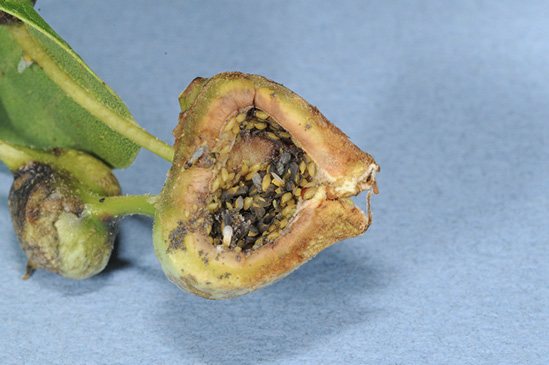
Yellow Pecan Aphids
Yellow aphids (Figure 14) feed on the undersides of pecan leaflets. Although trees can sustain populations as high as 30 aphids per compound leaf without suffering serious yield loss, high numbers of yellow aphids produce large amounts of honeydew. In landscape settings honeydew and sooty mold are often of greater concern than yield effects, especially for trees growing near patios or parking areas.
Control: In most cases, it is best not to try to control yellow aphids with insecticide sprays in home landscapes. Aphids are difficult to control with sprays, and sprays can cause aphid populations to increase by disrupting natural biological control.
Homeowners may wish to attempt to control aphids on trees growing over patios, parking areas, and similar sensitive sites using the systemic insecticide imidacloprid as a soil-applied drench. Apply after trees leaf out in the spring. Treatment rate is based on trunk circumference, and the cost to treat large trees can be significant. Although treatment is costly and results are erratic, this treatment is relatively safe and easy to apply in urban landscape settings. Imidacloprid may be applied only once per year. Keeping trees properly watered following treatment may improve control.

Black Pecan Aphids
Black pecan aphids (Figure 15) also feed on undersides of leaflets, but when compared aphid for aphid, black aphids are much more damaging than yellow aphids. The saliva they inject while feeding is toxic and results in the formation of angular yellow spots on the leaflets (Figure 15). These spots will eventually turn brown, and heavy infestations cause trees to lose leaves earlier than normal.
Control: Some cultivars of pecans are more susceptible to black pecan aphids than others. Sumner, Schley, and Gloria Grande are examples. Avoid planting cultivars that are especially susceptible to black pecan aphids. Soil-applied systemic treatments of imidacloprid, as described for yellow aphids, will also help control black aphids.
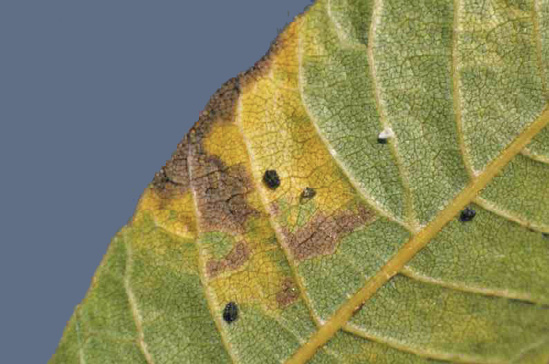
Pecan Weevils
These insects cause BB-sized holes in the nuts (Figure 16). These are emergence holes made by mature larvae chewing out of the nut. Adult pecan weevils (Figure 17) use their long proboscis to chew into nuts at the shell-hardening stage and deposit eggs in the nuts. The legless white larvae (Figure 16) consume the interior of the nut, chew an exit hole, drop to the ground, and dig into the ground to pupate. It takes 2 or 3 years to complete a generation, and adult weevils begin emerging from the soil in late July to August. Although pecan weevils occur throughout the state, they are less common in the Delta.
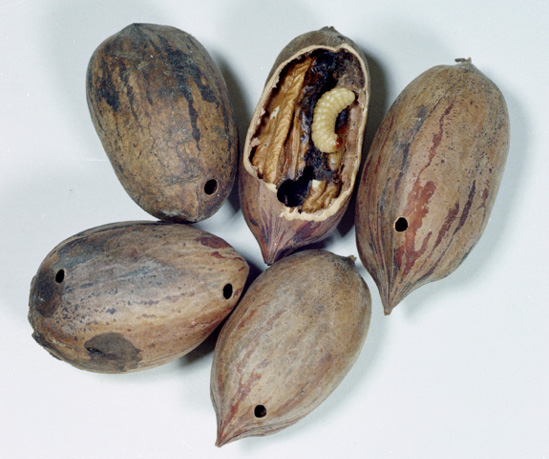
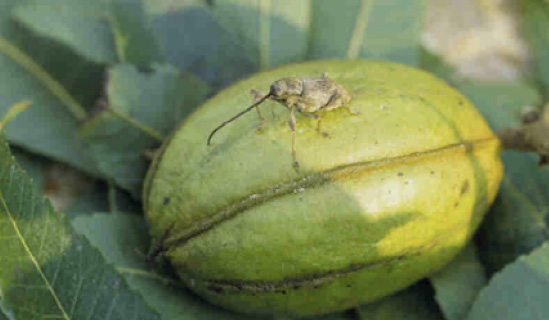
Control: In commercial orchards, pecan weevils are controlled by applying a series of sprays, usually Sevin (carbaryl), at 7- to 10-day intervals. Treatments are initiated at shell-hardening, and four to six treatments are applied. Such whole-tree foliar sprays are usually not feasible for landscape pecan trees.
Although adult pecan weevils can fly, a large portion of emerging weevils crawl or fly to the lower part of the trunk and then crawl higher into the tree. Home orchardists can obtain partial control of pecan weevils by applying a series of Sevin (carbaryl) or bifenthrin sprays to the lower 8 feet of the trunk and to the ground underneath the tree. The objective is to control emerging weevils before they can make their way into the canopy. Make the first treatment at the shell-hardening stage and apply two to four additional treatments at 7- to 10-day intervals. In the absence of information on nut stage or weevil emergence, begin treatments around the second week of August.
Wrapping the trunk with a 12- to 18-inch-wide band of cloth and applying Tanglefoot over this band to trap climbing weevils may improve control somewhat. Remove these bands promptly once weevil emergence is finished to prevent damage to the tree. Although these treatments will not fully control pecan weevils, they will reduce weevil numbers and the percentage of weevil-damaged nuts, and they are about the only available options for home orchardists who cannot apply whole-canopy sprays.
Stink Bugs
Stink bugs (Figure 18) damage pecans by feeding on hardening and maturing nuts with their piercing-sucking mouthparts, causing dark sunken spots in the kernels. Although stink bugs do not reproduce on pecans, heavy infestations of adult stink bugs migrating from ripening field crops will accumulate in pecan trees in late summer and fall. This is most likely to occur in the Delta region of the state or in other areas where there are concentrations of field crops such as soybeans, corn, sorghum, or cotton.
Control: Commercial producers control stink bugs by applying repeated applications of foliar insecticide sprays containing active ingredients such as bifenthrin or other labeled pyrethroids when stink bugs are present in the orchard. There are no good stink bug control options for home orchardists who cannot apply such sprays.
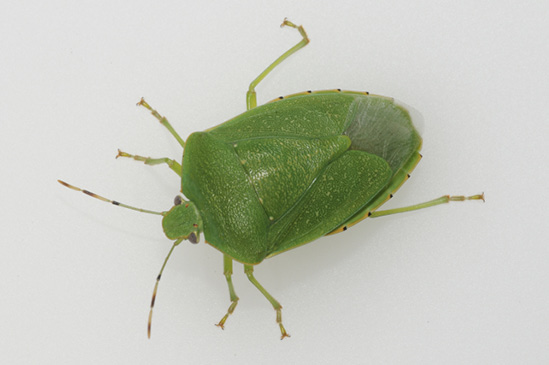
Fall Webworms
These caterpillars build unsightly web tents around the leaves at the ends of pecan limbs (Figure 19). Heavy infestations occur more frequently in the southern portion of the state but occur sporadically in North Mississippi. In outbreak years, fall webworm infestations can cause near complete defoliation of trees in late summer and fall. This rarely affects tree survival or longevity, but trees affected in this way will have poorly filled nuts in the current year and suffer from reduced production the following year, and trees infested with large numbers of tents are unsightly in home landscapes. Commercial producers often do not treat for webworms specifically because the sprays they apply for other pests provide collateral control of webworms.
Control: Do not attempt to burn webs from trees. Pecan twigs totally defoliated by webworms will produce new leaves; twigs damaged by fire will not! A mechanical control method is to use a wire hook attached to the end of a long pole to tear up tents and increase caterpillar exposure to predators such as birds and wasps.
Home orchardists can also control webworms on small trees, or on the lower portions of larger trees, by using a tree and shrub hose-end applicator to apply sprays containing the active ingredient spinosad, taking care to penetrate the web with the spray and treat surrounding leaves. With adequate water pressure, such applicators will reach up to about 20 feet. If available, other types of sprayers will provide better spray coverage and control. Pyrethroid insecticides, such as bifenthrin, cyfluthrin, and permethrin, will also control caterpillar pests but are more likely to trigger outbreaks of mites and aphids.
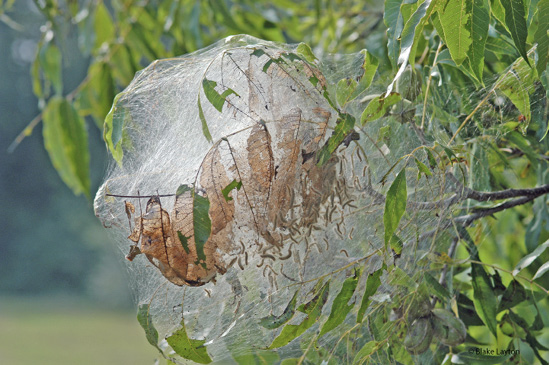
Walnut Caterpillars
Walnut caterpillars do not build webs. These caterpillars remain exposed on the leaves, defoliating individual limbs or areas of pecan trees. When they are ready to shed their skins in order to grow larger, walnut caterpillars group together on the trunk (Figure 20), leaving a strange looking mass of shed skins attached to the trunk after they have moved back out on the limb to continue feeding. Walnut caterpillars change in appearance as they grow. Young caterpillars are red and white or yellow-striped, while mature caterpillars are black with sparse white hairs.
Control: When they are found massed together on the tree trunk to molt, walnut caterpillars can be killed easily by spraying directly with a labeled contact insecticide (spinosad, bifenthrin, or carbaryl will work), but it is difficult to “catch” the caterpillars in this vulnerable state. Otherwise, tree and shrub hose-end sprayers can be used to apply products containing spinosad to control walnut caterpillars as high as the sprayer will reach.

Twig Girdlers
These large beetles (Figure 21) damage pecans by girdling pencil-sized twigs in the fall, causing them to break off and drop to the ground. Females lay eggs in the twigs before they drop from the tree. Heavy infestations are most often encountered in trees near wooded areas with many hickories and other hardwood trees. Young trees are especially susceptible to injury by twig girdlers because the twigs that are pruned are supposed to be developing into the central leader and major limbs of the tree.
Control: Pick up and destroy fallen twigs before eggs hatch to reduce populations in subsequent years. Partially protect young trees by spraying with bifenthrin. Adults may be active from late August through late October.
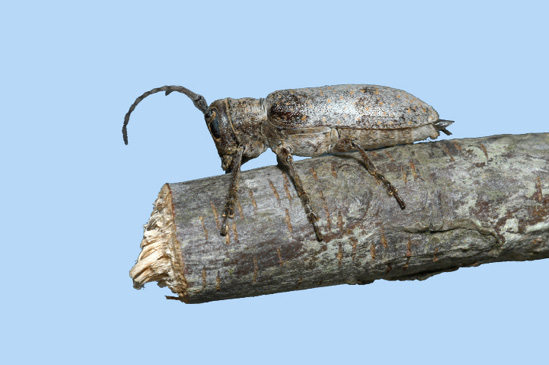
Other Pests of Pecans
Pecans are attacked by several other insect and mite pests. These include pecan nut casebearers, spider mites, pecan leaf scorch mites, hickory shuckworms, obscure scale, and spittlebugs. Most of these are occasional pests, and it is usually not practical to attempt to control these pests on pecan trees in home landscapes.
References
Brewer, M. T., Cameron, C. J., Chan, C. T., Dutta, B., Gitaitis, R. D., Grauke, L. J., Brock, J. H., & Brenneman, T. B. (2021). Neofusicoccum caryigenum, a new species causing leaf dieback disease of pecan (Carya illinoinensis). Mycologia 113, 586–598.
Standish, J. R., Brenneman, T. B., Bock, C. H., & Stevenson, K. L. (2021). Fungicide resistance in Venturia effusa, cause of pecan scab: Current status and practical implications. Phytopathology 111, 244–252.
Teviotdale, B. L., Michailides, T. J., & Pscheidt, J. W. (Eds.). (2002). Compendium of nut crop diseases in temperate zones. American Phytopathological Society Press.
Additional Resources
Matta, F., Braswell, J., Rasberry, F., Mullenax, R., & Davis, J. (2015). Fruit and nut review: Pecans in the home landscape. MSU Extension Service, IS1432.
Bachman, G. R., & Mullenax, R. (2021). Repairing storm-damaged shade, ornamental, and fruit trees. MSU Extension Service, P3667.
Melanson, R. A. (2024). Pecan scab in the home landscape. MSU Extension Service, P3966.
Melanson, R. A., & Sanderlin, R. S. (2022). Pecan bacterial leaf scorch. MSU Extension Service, P3005.
Wells, L. (Ed.). (2024). 2024 commercial pecan spray guide. University of Georgia, Bulletin 841.
This work is partially supported by Crop Protection and Pest Management, Extension Implementation Program, award no. 2021-70006-35580, from the USDA National Institute of Food and Agriculture. Any opinions, findings, conclusions, or recommendations expressed in this publication are those of the author and do not necessarily reflect the view of the U.S. Department of Agriculture.
Publication 3967 (POD-03-24)
Prepared by Rebecca A. Melanson, PhD, Associate Extension Professor, Plant Pathology, Central Mississippi Research and Extension Center, and Blake Layton, PhD, Professor, Entomology. Reviewed by Clarissa Balbalian, Plant Diagnostic Laboratory Manager, MSU Extension; Eric Stafne, PhD, Professor, Horticulture, Coastal Mississippi Research and Extension Center; Jessica Sibley, DeSoto County Extension Agent, MSU Extension; and Randy Sanderlin, PhD, Professor (retired), Plant Pathology, LSU AgCenter.
The Mississippi State University Extension Service is working to ensure all web content is accessible to all users. If you need assistance accessing any of our content, please email the webteam or call 662-325-2262.



